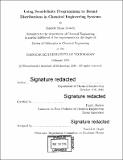Using semidefinite programming to bound distributions in chemical engineering systems
Author(s)
Dowdy, Garrett Ryan.
Download1103917704-MIT.pdf (22.55Mb)
Other Contributors
Massachusetts Institute of Technology. Department of Chemical Engineering.
Advisor
Paul I. Barton.
Terms of use
Metadata
Show full item recordAbstract
Distributions appear in many forms in models of chemical engineering systems. Such distributions account for microscopic variability in the system while simultaneously explaining its macroscopic properties. These macroscopic properties are often of practical engineering interest. Thus, it is valuable to be able to characterize the underlying distributions that affect them. Recently, in the mathematical programming literature, it was shown that it is possible to optimize a linear objective over a set of distributions by solving a specific type of convex optimization problem called a semidefinite program (SDP). From a theoretical perspective, SDPs can be solved efficiently. Furthermore, there exist several off-the-shelf codes designed specifically to solve SDPs. This thesis demonstrates how these theoretical and practical advancements can be applied to chemical engineering problems featuring distributions. Broadly speaking, it shows how, given limited information about a distribution, one can use SDPs to calculate mathematically rigorous bounds on various descriptions of that distribution. Two specific types of distributions are examined: particle size distributions and probability distributions arising in stochastic chemical kinetics, with the majority of the thesis covering the latter topic. The SDP-based bounding method described herein provides a rigorous solution to the long-standing "moment closure problem" arising in stochastic chemical kinetics. Moreover, it provides a means of analyzing of stochastic chemical kinetic systems which cannot be effectively analyzed using existing methods. The bounding method does have some limitations, and we present several refinements of the method aimed at overcoming these limitations. Finally, we discuss several ideas through which the bounding method may be further improved, which have not yet been explored.
Description
Thesis: Ph. D., Massachusetts Institute of Technology, Department of Chemical Engineering, 2019 Cataloged from PDF version of thesis. Includes bibliographical references (pages 329-334).
Date issued
2019Department
Massachusetts Institute of Technology. Department of Chemical EngineeringPublisher
Massachusetts Institute of Technology
Keywords
Chemical Engineering.